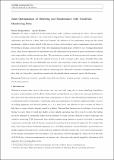Joint optimization of ordering and maintenance with condition monitoring data
Author(s)
Moghaddass, Ramin; Ertekin, Şeyda
Download10479_2017_2745_ReferencePDF.pdf (519.9Kb)
Publisher Policy
Publisher Policy
Article is made available in accordance with the publisher's policy and may be subject to US copyright law. Please refer to the publisher's site for terms of use.
Terms of use
Metadata
Show full item recordAbstract
Abstract
We study a single-unit deteriorating system under condition monitoring for which collected signals are only stochastically related to the actual level of degradation. Failure replacement is costlier than preventive replacement and there is a delay (lead time) between the initiation of the maintenance setup and the actual maintenance, which is closely related to the process of spare parts inventory and/or maintenance setup activities. We develop a dynamic control policy with a two-dimensional decision space, referred to as a warning-replacement policy, which jointly optimizes the replacement time and replacement setup initiation point (maintenance ordering time) using online condition monitoring data. The optimization criterion is the long-run expected average cost per unit of operation time. We develop the optimal structure of such a dynamic policy using a partially observable semi-Markov decision process and provide some important results with respect to optimality and monotone properties of the optimal policy. We also discuss how to find the optimal values of observation/inspection interval and lead time using historical condition monitoring data. Illustrative numerical examples are provided to show thatour joint policy outperforms conventional suboptimal policies commonly used in theliterature.
Date issued
2018-01-04Department
Sloan School of ManagementPublisher
Springer US